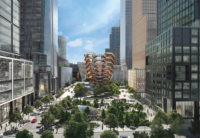

In 2004, after reviewing a number of potential cities, government officials selected one of Lens’s former mines—now a green, hilly pasture—as the site for the first Louvre satellite museum. Following an international competition, the team of Tokyo-based SANAA and New York/Paris-based Imrey Culbert was selected in September 2005. After a series of permitting and financing processes, the 150 million euro ($216 million USD), 183,000 square-foot structure has begun construction, with an intended completion date in 2012.
The museum is to consist of five pavilions, connected at their corners. Aside from the glass entrance pavilion, the buildings will be clad in a reflective aluminum, which will mirror the pastoral surroundings in blurred form. Louis-Antoine Grégo, project architect for SANAA, is working with local architects, Extramuros, to take the project toward completion. He says the curvature of the buildings will add to the ethereal effect: “As you walk by, the building will change, helping to subtly integrate the building in the site.”
From a curatorial standpoint, the museum is intended to display art from the Louvre’s vast collection, which spans eight departments (Near Eastern Antiquities; Egyptian Antiquities; Greek, Etruscan, and Roman Antiquities; Islamic Art; Decorative Arts; Prints and Drawings; Sculptures; and Paintings). The Lens branch will display rarely seen pieces and will highlight the archival and conservation roles of the institution with a series of visible, below-grade storage areas. “It’s an idea of excavation and layers,” explains Celia Imrey, principal of Imrey Culbert, which is no longer involved with the project. “But it’s still about a museum and a museum program, not a gesture that is tacked on.”
Another main feature will be the Gallery of Time, curated by French museographer Adrien Gardère. The large, continuous gallery will have artwork arranged chronologically and will emphasize cross-cultural connections by displaying art produced in different places at the same time. (For instance, it might show what was being made in Greece and China while the Pyramids were being constructed.)
With more than 700,000 visitors anticipated for its opening year, Louvre-Lens could catalyze a regeneration of the surrounding area – and help a former mining town prosper in the 21st century.




